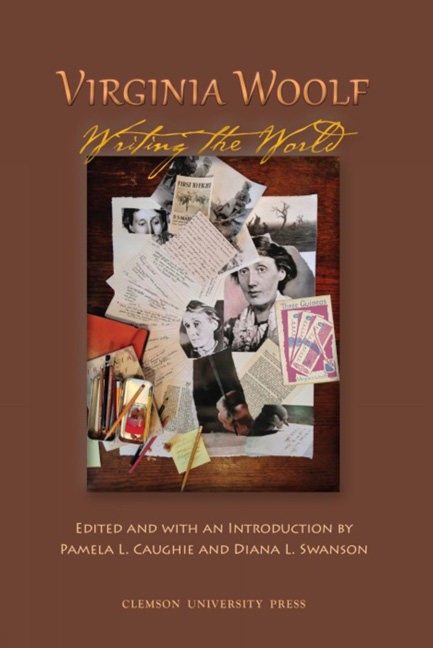Book contents
- Frontmatter
- Table of Contents
- Introduction
- Acknowledgmen
- Abbreviation
- WAR AND PEACE
- WORLD WRITER(S)
- ANIMAL AND NATURAL WORLD
- “And the donkey brays”: Donkeys at Work in Virginia Woolf
- Companion Creatures: “Dogmanity” in Three Guineas
- Virginia Woolf's Object-Oriented Ecology
- The Bodies In/Are The Waves
- Stretching our “Antennae”: Converging Worlds of the Seen and the Unseen in “Kew Gardens”
- “The Problem of Space”: Embodied Language and the Body in Nature in To the Lighthouse
- “Whose Woods These Are”: Virginia Woolf and the Primeval Forests of the Mind
- WRITING AND WORLDMAKING
- Notes on Contributors
- Conference Program
- Appendix: Virginia Woolf Conference Exhibit Items, Newberry Library
Stretching our “Antennae”: Converging Worlds of the Seen and the Unseen in “Kew Gardens”
from ANIMAL AND NATURAL WORLD
- Frontmatter
- Table of Contents
- Introduction
- Acknowledgmen
- Abbreviation
- WAR AND PEACE
- WORLD WRITER(S)
- ANIMAL AND NATURAL WORLD
- “And the donkey brays”: Donkeys at Work in Virginia Woolf
- Companion Creatures: “Dogmanity” in Three Guineas
- Virginia Woolf's Object-Oriented Ecology
- The Bodies In/Are The Waves
- Stretching our “Antennae”: Converging Worlds of the Seen and the Unseen in “Kew Gardens”
- “The Problem of Space”: Embodied Language and the Body in Nature in To the Lighthouse
- “Whose Woods These Are”: Virginia Woolf and the Primeval Forests of the Mind
- WRITING AND WORLDMAKING
- Notes on Contributors
- Conference Program
- Appendix: Virginia Woolf Conference Exhibit Items, Newberry Library
Summary
In “Modern Fiction” (1925), Virginia Woolf famously writes, “Let us not take it for granted that life exists more fully in what is commonly thought big than in what is commonly thought small” (CE2 107). She encourages us to look beneath the main “plot” and action of our lives to find the portion which “escapes” (105). In speaking of the “worlds” of Woolf's writing, we must remember that Woolf draws our attention repeatedly to the smaller moments of life, even the smaller beings. In Woolf's fiction, children particularly discover large worlds in minute things; in To the Lighthouse (1927), Nancy's imagination changes a tidal pool “into the sea” (75) and in The Waves (1931), Bernard, crawling under the canopy, finds the “stalks of flowers are thick as oak trees” (23). Woolf privileges the ability to imagine the world from a perspective unseen by most adults so that objects and ideas previously overlooked become magnified. These passages find a precursor much earlier in “Kew Gardens” (1919) in which Woolf uses an “oval-shaped flower-bed” as a stage and records both the microcosm of action in it and the macrocosm of people passing around it (AHH 28). As flowers unfurl, colored lights shift, and a snail crawls, the primary world is established and the people seem mere curious passersby. As Diana L. Swanson has written, the “human world is no longer the center of her writerly universe” (54). By making her focus a sensitive snail, feeling for a path with his retractable horns, who encounters an “angular green insect” with “its antennae trembling” (30), Woolf reveals how much of everyday life we humans miss. The antennae become a symbol of this extrasensory awareness Woolf allows her human characters to achieve in the garden.
The Royal Botanic Gardens at Kew cover 121 hectares and house 30,000 kinds of plants (kew.org). It is then remarkable that Woolf chose for her short story to be confined to such a small space—primarily the world of a snail and what can be perceived from his flower-bed.
- Type
- Chapter
- Information
- Virginia Woolf: Writing the World , pp. 160 - 166Publisher: Liverpool University PressPrint publication year: 2015



